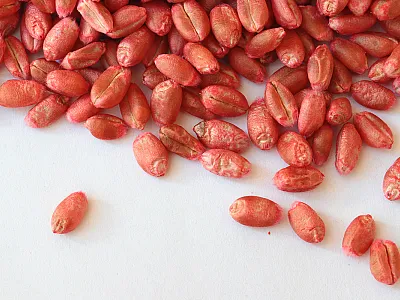Evaluation of Urease and Nitrification Inhibitors in Western Canada
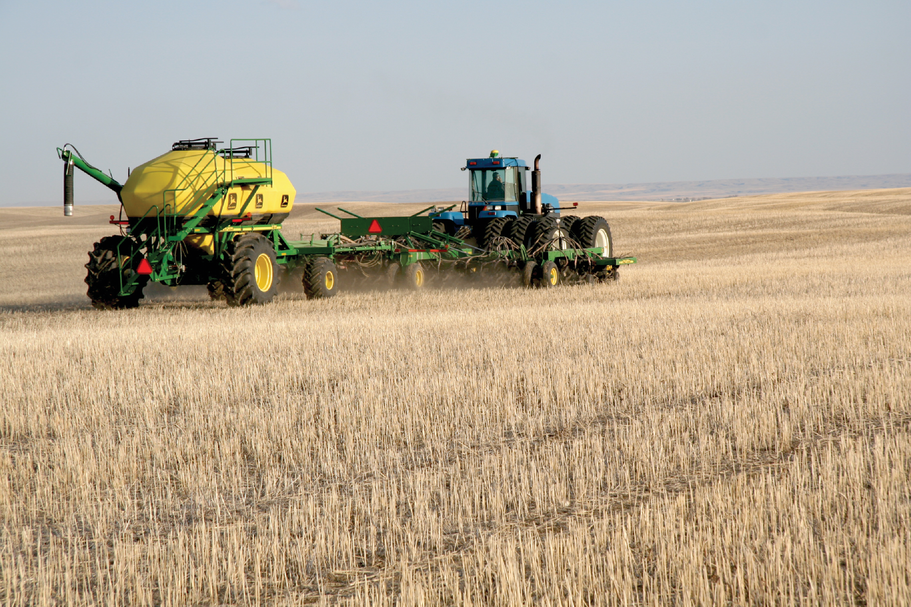

The recovery of fertilizer nitrogen by crops in the year of application is usually cited as being about 50%, despite considerable efforts to improve nitrogen efficiencies in agricultural systems. The use of fertilizer additives containing urease and/or nitrification inhibitors may improve fertilizer N efficiency. This was evaluated in four experiments conducted at multiple locations across the Canadian Prairies. Earn 0.5 CEUs in Nutrient Management by reading the article and taking the quiz at https://web.sciencesocieties.org/Learning-Center/Courses.
The recovery of fertilizer nitrogen by crops in the year of application is usually cited as being about 50%, despite considerable efforts to improve nitrogen efficiencies in agricultural systems. Agricultural systems in western Canada are currently dominated by no-till dryland production of spring cereal, oilseed, and pulse crops with most nitrogen fertilizer banded at the time of planting. Figure 1 summarizes the results of western Canadian studies that used 15N to determine the fate of fertilizer N in cropping systems (99.63% of nitrogen atoms are the 14N isotope; enriching fertilizer N with the 15N isotope allows direct recovery of fertilizer N to be determined). The median crop uptake of fertilizer nitrogen in these studies was 36%.
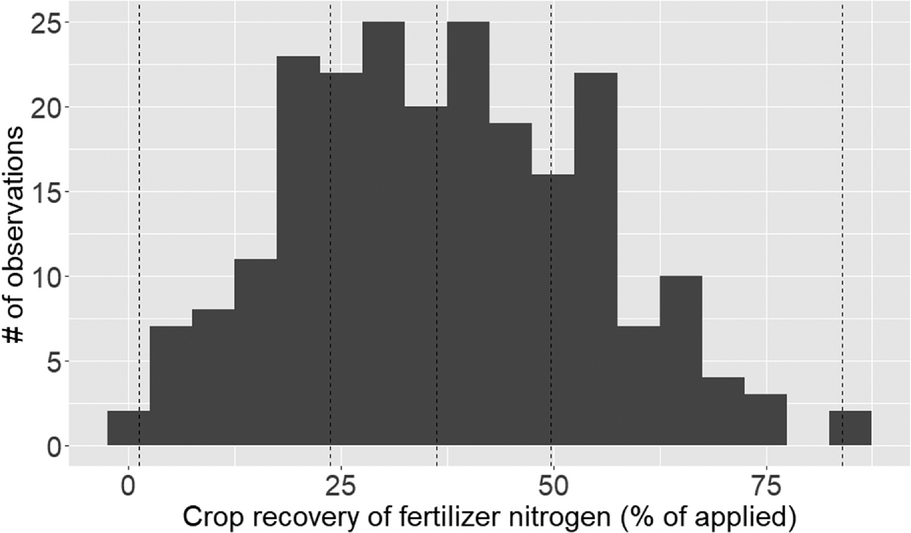
The observations included in Figure 1 included all treatments used in studies, even those now known to have poor efficacy. Management factors most often related to low recovery of fertilizer N in these studies were fall application and surface placement. Application of fertilizer in the fall rather than the spring reduced crop recovery of fertilizer N from 39 to 24% (P<0.001 based on 14 paired comparisons). Over the winter period, fertilizer N may be lost by leaching, denitrification, or immobilization. Surface application of urea without incorporation, rather than banding at depth, reduced crop recovery of urea N from 48 to 32% (P<0.01 based on five paired comparisons). Broadcast urea N may be lost due to ammonia volatilization. Excluding treatments known to have reduced recovery, the median recovery of fertilizer N in aboveground biomass of crops in the year of application in western Canada was 45%, comparable to global estimates (Smil, 1999; Ladha et al., 2005). Total recovery in crops and soil was 81%.
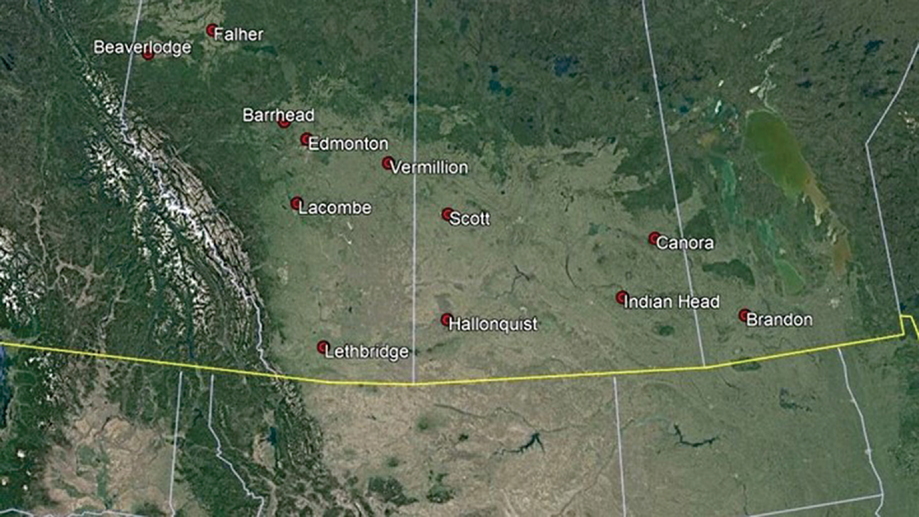
The use of fertilizer additives containing urease and/or nitrification inhibitors may improve fertilizer N efficiency. Urease inhibitors slow the conversion of urea to ammonia, thus reducing the risk of N loss via ammonia volatilization when urea is broadcast or possibly even sub-optimally banded at shallow depths or with poor furrow closure. The dominant active ingredient used as a urease inhibitor is NBPT (Cantarella et al., 2018). Nitrification inhibitors slow the conversion of ammonium to nitrate, thus reducing the risk of N loss via leaching or denitrification of nitrate. Active ingredients used in commercial nitrification inhibitors include nitrapyrin, DCD, DMPP, DMPSA, and pronitridine (Ruser & Schulz, 2015).
The effectiveness of urease and nitrification inhibitors to improve fertilizer N efficiency and wheat yield was evaluated in four experiments conducted at multiple locations across the Canadian prairies (Figure 2). Three products were tested: (1) a urease inhibitor (UI) with NBPT as the active ingredient (Agrotain, Koch Agronomic Services, St. Louis, MO, USA), (2) a nitrification inhibitor (NI) with nitrapyrin as the active ingredient (eNtrench, Corteva Agriscience Canada, Calgary, AB, Canada), and (3) a dual inhibitor (UI+NI) with NBPT as the urease inhibitor and dicyandiamide as the nitrification inhibitor (SuperU, Koch Agronomic Services, St. Louis, MO, USA). Inhibitors were applied at different timings/placements or N rates, depending on experiment (Table 1). Experiments were conducted over a total of 87 site-years.
The impact of inhibitors on urea effectiveness to increase crop nitrogen uptake and yield in these experiments was small and rarely statistically significant (Figure 3). Relative to the urea control, inhibitors increased average crop N uptake by 0.4 to 4.2% and grain yield by 0.3 to 2.4%. Despite modest yield benefits and increased cost, inhibitors increased net returns by 0.5 to 1.0%, i.e., breakeven.
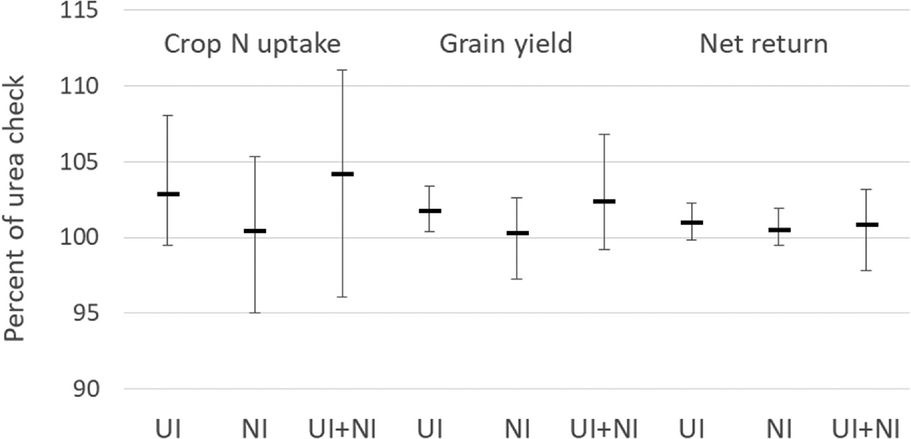
One explanation for the limited benefit of inhibitors for crop N uptake in these experiments is that losses of urea N were low. Most ammonia losses from broadcast urea occur within three to five days of application though losses may persist for up to two weeks. Based on a global review, Bouwman et al. (2002) estimated that the median loss of ammonia from synthetic fertilizers was 14%. Based on the increase in unaccounted 15N in western Canada (Figure 1), an average of 10% (range 1 to 16%) of surface-applied urea N was lost via ammonia volatilization. Nitrogen losses via ammonia volatilization in the studies summarized in Figure 3 were further constrained because only a fraction of urea was broadcast in most treatments (Table 1). Of note, the maximum benefit of urease inhibitors on crop N uptake was observed in the only treatment where all urea was broadcast (Beres et al., 2018). Losses of nitrate formed from urea via leaching and denitrification occurs when a period of excessive moisture occurs after urea is converted to nitrate and prior to uptake by crops. Periods of excessive moisture are uncommon under the semiarid climate of the Canadian Prairies but may still occur in winter or spring in wetter regions or years. Based on the 15N studies in western Canada summarized in Figure 1, an average of 35% (n=56) of fall-applied and 19% (n=139) of spring-applied fertilizer N was not recovered in crops or soil after one growing season.
Table 1. Overview of four experiments conducted to evaluated urease and nitrification inhibitors in western Canada.
Experiment publication | Wheat crop | Site-years | Urea N rate(s) | Timing and placement |
|---|---|---|---|---|
Beres et al., 2018 | Winter | 15 | 80% of | 1. Fall band |
Fast et al., 2023 | Spring | 23 | 60, 120, 180, | Spring band |
Wang et al., 2023 | Winter | 24 | 80% of | 1. Fall band (FB) |
Wang et al., | Spring | 25 | 100% of | 1. Spring band (SB) |
aBased on PRS Probe technology and PRS Cropcaster, Western Ag Innovations, Saskatoon, SK.
Limited increases in crop N uptake also occur because inhibitors are only partially effective at reducing N losses from applied urea. The activity of inhibitors declines over a time period of days to weeks, generally sufficient to reduce losses by ammonia volatilization from broadcast urea but not necessarily of leaching or denitrification losses. Based on a review of published studies, Cantarella et al. (2018) concluded that that NBPT reduced ammonia losses from broadcast urea by an average of 53% (range ≈0 to 80%). In a study conducted in Manitoba, application of NBPT reduced ammonia loss from broadcast urea by 28 to 88% (Rawluk et al., 2001). Nitrification inhibitors have highly variable impacts on nitrate leaching but may reduce N2O emissions from denitrification and nitrification by approximately 35% (Ruser & Schulz 2015; Woodward et al. 2021). Soil N2O emissions are lower under the semiarid conditions of western Canada than in more humid regions, and inhibitors have provided inconsistent reductions in N2O emissions to date (Thilakarathna et al., 2020; Wang et al., 2023).
Another reason for the limited impact of inhibitors in these studies is that the supply of N from soil accounts for 50% or more of the N acquired by crops but is negligibly impacted by the addition of inhibitors. In these studies, crops typically acquired 62 to 116 lb N/ac from soil. Finally, the yield benefit of increased N supply declines with increasing N fertility, particularly for wheat because N is required to achieve acceptable grain protein concentrations as well as yield. A 10% increase in N fertilizer rate increases wheat yield by about 2.5% when N fertilizer rates are at 80% of that required to obtain acceptable protein and yield (PRS Cropcaster, Western Ag Innovations).
Assuming that 30% of urea N is lost (higher than average) and inhibitors reduced these losses by 50%, the calculated benefit of urease and nitrification inhibitors is about 10% for crop N uptake and 2.5% for wheat yield. These values are consistent with the high end of observed values in the studies summarized in Figure 3. Benefits of this magnitude are difficult to quantify using agronomic field trials but may be more reliably measured using 15N. The use of urease and nitrification inhibitors did not provide a large agronomic benefit in the field trials reported here, but given the high cost of urea fertilizer, potential reductions in ammonia volatilization and N2O emissions, and variability in weather, these products may still be useful to improve cropping systems in this region.
Summary/Takeaways
1. The median recovery of fertilizer N based on published 15N studies in western Canada is 36%, but this value increases to 45% if fall and broadcast urea applications are excluded.
2. Based on four field experiments conducted at multiple locations across western Canada from 2007 to 2022, urease and nitrification inhibitors did not significantly increase grain yields of winter and spring wheat in most cases, but net returns were maintained despite increased costs.
3. In this region, the benefit of inhibitors was constrained by modest N losses, partial efficacy of inhibitors to reduce N losses, and the contribution of soil N.
4. The use of urease and nitrification inhibitors may be useful to reduce N losses under variable weather or reduce N2O emissions.
Acknowledgements
We would like to thank the following for funding of inhibitor studies: AAFC’s Growing Forward Program, Alberta Grains, Western Grains Research Foundation, Saskatchewan Winter Cereals Development Commission, Nutrien, Corteva, Koch Agronomic Services, Saskatchewan Wheat Commission, and Alberta Innovates.
References
Beres, B.L., Graf, R.J., Irvine, R.B., O’Donovan, J.T., Harker, K.N., Johnson, E.N., ... & Stevenson, F.C. (2018). Enhanced nitrogen management strategies for winter wheat production in the Canadian prairies. Canadian Journal of Plant Science, 98, 683–702. https://doi.org/10.1139/cjps-2017-0319
Bouwman, A.F., Boumans, L.J.M., & Batjes, N.H. (2002). Estimation of global NH3 volatilization loss from synthetic fertilizers and animal manure applied to arable lands and grasslands. Global Biogeochemical Cycles, 16, 8-1-8-14. https://doi.org/10.1029/2000GB001389
Cantarella, H., Otto, R., Soares, J.R., & Silva, A.G.d.B. (2018). Agronomic efficiency of NBPT as a urease inhibitor: A review. Journal of Advanced Research, 13, 19–27. https://www.sciencedirect.com/science/article/pii/S2090123218300638
Fast, A., Strydhorst, S., Wang, Z., Hernandez-Ramirez, G., Hao, X., Semach, G., ... & Beres, B.L. (2023). Integrating enhanced efficiency fertilizers and nitrogen rates to improve Canada Western Red Spring wheat. Canadian Journal of Plant Science. https://doi.org/10.1139/CJPS-2023-0095
Ladha, J.K., Pathak, H.J., Krupnik, T., Six, J., & van Kessel, C. (2005). Efficiency of fertilizer nitrogen in cereal production: Retrospects and prospects. Advances in Agronomy, 87, 85156. https://www.sciencedirect.com/science/article/pii/S0065211305870038
Rawluk, C.D.L., Grant, C.A., & Racz, G.J. (2001). Ammonia volatilization from soils fertilized with urea and varying rates of urease inhibitor NBPT. Canadian Journal of Soil Science, 81, 239–246. https://cdnsciencepub.com/doi/abs/10.4141/s00-052
Ruser, R., & Schulz, R. (2015). The effect of nitrification inhibitors on the nitrous oxide (N2O) release from agricultural soils—a review. Journal of Plant Nutrition and Soil Science, 178, 171–188. https://doi.org/10.1002/jpln.201400251
Smil, V. (1999). Nitrogen in crop production: An account of global flows. Global Biogeochemical Cycles, 13, 647–662. https://doi.org/10.1029/1999GB900015 Thilakarathna, S.K., Hernandez-Ramirez, G., Puurveen, D., Kryzanowski, L., Lohstraeter, G., Powers, L.-A., Quan, N., & Tenuta, M. (2020). Nitrous oxide emissions and nitrogen use efficiency in wheat: Nitrogen fertilization timing and formulation, soil nitrogen, and weather effects. Soil Science Society of America Journal, 84, 1910–1927. https://doi.org/10.1002/saj2.20145
Wang, Z., Owens, J.L., Thomas, B.W., Hao, X., Coles, K., Holzapfel, C., ... & Beres, B.L. (2023). Winter wheat responses to enhanced efficiency granular nitrogen fertilizer in the Canadian Prairies. Canadian Journal of Plant Science, 103,368–388. https://doi.org/10.1139/cjps-2022-0209
Woodward, E.E., Edwards, T.M., Givens, C.E., Kolpin, D.W., & Hladik, M.L. (2021). Widespread use of the nitrification inhibitor nitrapyrin: assessing benefits and costs to agriculture, ecosystems, and environmental health. Environmental Science & Technology, 55, 1345– 1353. https://doi.org/10.1021/acs.est.0c05732
Self-Study CEU Quiz
Earn 1 CEU in Nutrient Management by taking the quiz for the article at https://web.sciencesocieties.org/Learning-Center/Courses. For your convenience, the quiz is printed below. The CEU can be purchased individually, or you can access as part of your Online Classroom Subscription.
- The proportion of fertilizer nitrogen recovered by crops in the year of application is typically
- 25%.
- 50%.
- 75%.
- 100%.
- The use of an urease inhibitor such as NBPT
- slows the conversion of ammonium to nitrate
- increases crop recovery of urea nitrogen by about 50%.
- reduces ammonia volatilization from broadcast urea by about 50%.
- reduces N2O emissions by about 35%.
- The use of nitrification inhibitors such as nitrapyrin, DCD, DMPP, DMPSA, and pronitridine
- slows the conversion of ammonium to nitrate.
- increases crop recovery of urea nitrogen by about 35%.
- reduces ammonia volatilization from broadcast urea by about 50%.
- increases N2O emissions.
- Lack of an improvement in crop nitrogen uptake due to the use of urease and nitrification inhibitors is evidence that
- urease and nitrification inhibitors are not inhibiting targeted transformations.
- crops had adequate nitrogen from sources other than applied urea.
- losses of urea nitrogen via ammonia volatilization, leaching, or denitrification are negligible under conventional practice.
- variability in crop nitrogen measurements is too high to allow detection of improvements.
- All of the above to varying degrees.
- The effectiveness of urease and nitrification inhibitors to increase crop nitrogen uptake is greatest when
- nitrogen losses from fertilizer are high immediately after fertilizer application.
- soil nitrogen availability is high.
- crop nitrogen requirements are high.
- All of the above.
Text © . The authors. CC BY-NC-ND 4.0. Except where otherwise noted, images are subject to copyright. Any reuse without express permission from the copyright owner is prohibited.







